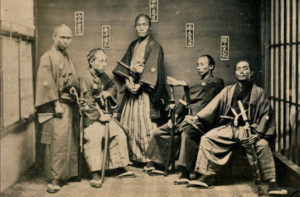Interesting facts about samurai
 At the word “samurai”, the imagination immediately draws a Japanese warrior armed with katana in traditional clothes of bygone years, stern and adamant. Of course, this is just a well-established romantic image, a kind of stereotype, but at one time the samurai were indeed the elite, akin to nobles in European countries. About them you can tell a lot of interesting facts, not very well known.
At the word “samurai”, the imagination immediately draws a Japanese warrior armed with katana in traditional clothes of bygone years, stern and adamant. Of course, this is just a well-established romantic image, a kind of stereotype, but at one time the samurai were indeed the elite, akin to nobles in European countries. About them you can tell a lot of interesting facts, not very well known.
All modern Japanese corporations, rich and powerful, were founded by the Japanese nobility, that is, members of these dynasties are direct descendants of the samurai.
Ronin was called a samurai who had lost his suzerain. It was believed that if a warrior allowed the death of his patron, it was he who was to blame for this, so they did not respect the ronin, though they were afraid.
The samurai had a very peculiar code of honor, sometimes quite cruel.
When meeting with another samurai, putting his weapon on the ground, instead of keeping it close at hand, was perceived by them not as a sign of peace, but as an insult – it was considered that this gesture was filled with contempt, since the one who voluntarily places the weapon on the ground he is afraid of his interlocutor and does not consider him a dangerous adversary.
One of the indispensable attributes of samurai clothing was the horo cape, several meters long. Good filled with light materials like fluff, and with every sudden movement the cape fluttered, slightly protecting its wearer from the arrows that could get entangled in this fabric.
The samurai began to make heavy swords with thicker blades after the first encounter with the Mongols, when the clashes showed that Japanese swords often break when they collide with heavy Mongol blades.
In public, samurai avoided expressing feelings for women, since it was believed that a woman makes a warrior weak and has a bad influence on him. Therefore, the ancient Japanese warriors married for procreation, but rarely attached great importance to the spouse. But same-sex relationships are not condemned at all by society.
In the event of an insult by someone from the lower class, the samurai had the legal right to immediately kill the abuser, but witnesses were to be present. A manifestation of mercy in this case was regarded as a weakness on the part of the samurai.
Bathrooms in the samurai houses were designed to prevent an attack at the delicate moment of meeting needs.
As a trophy, samurai usually took the heads of defeated noble warriors. The heads of peasants and commoners were not considered valuable trophies.
Often, samurai camouflaged as Buddhist monks, and as a weapon they used shakuhachi, a traditional flute, but covered with spikes.
Samurai code of honor took shape only in the 17th century. Prior to this, the overlord’s betrayal was a fairly common affair.
Most samurai preferred death to captivity – in a hopeless situation, they either fought to the end or killed themselves on their own to deprive the enemy of this honor.
In medieval Japan, women were included in the samurai estate. They did not take part in the wars, but trained and had weapons to protect the house.
Samurai armor was usually made of metal plates. The metal is varnished so that it does not rust.
Samurai wives often committed suicide after the death of her husband, but only with the consent of the parents.
Sometimes samurai wore depicting faces of demons masks in order to intimidate enemies.
By law, each samurai could carry two swords at the same time. But the peasants were generally forbidden to have a weapon.
The first foreigner to become a samurai is the English merchant and navigator William Adams.
In medieval Japan, about 10 percent of the male population was samurai. In different eras, this figure has changed, but only slightly.



























